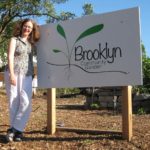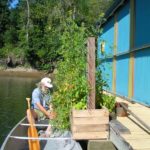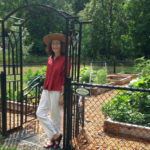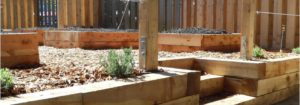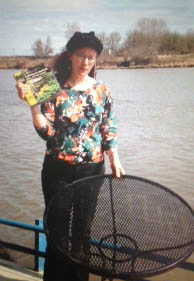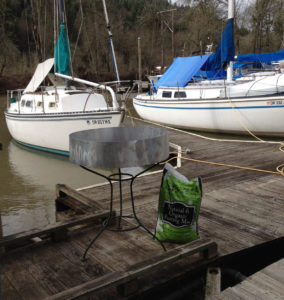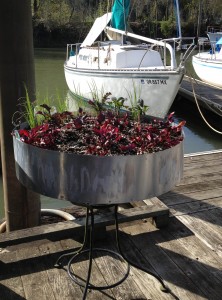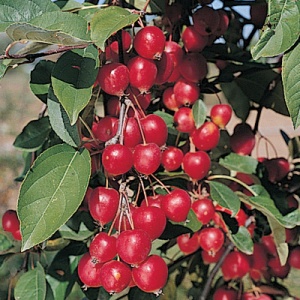Growing Greens Above Ground Some of you may know from a previous newsletter that I built a “Salad” table from an old metal patio table. My initial planting grew poorly because my soil was compacted from a hard rain right after I put the potting soil into the table. I had stunted baby beets and very slow growing shallots. I figured it out and l loosened up the soil with a small hand fork. All the plants started to grow. Next year I will add a shade cover when it gets into the high temps to prevent or minimize the bitter taste lettuce gets in heat. The cover also slows down summer bolting.
Archive for Easy Edibles – Page 4
I Finally Have My Own Community Garden Plot!
Last year I did some volunteer design work for the SE Portland Brooklyn Community Garden. I saw people working on their gardens, hanging out and eating together under an old plum tree. It looked like good clean fun to me and I was a little envious. These days I live on a floating home and have a tiny roof garden (courtesy of my hubs great design and building skills) and large bodacious tomato planters on the south side. I’d never considered a community garden before and now that I live on the edge of NW Portland I felt they would be too far into town to be practical.
Magic Happens!!!!
Jen and Stan Tonneson own and manage the Rocky Pointe Moorage, on the Willamette River (Multnomah Channel) where I live. They decided to build a private community garden for their tenants and also to romance new tenants for The Landing at Rocky Pointe. They built the beds, brought in soil, installed a hose bib and fenced it to keep critters out. I was the first person to sign up and my neighbors joined in. My dad and I were the gardeners when I was a kid and I have many happy memories of working with him in the garden. I have not had a veggie garden since although I have designed so many ….
Now I love my garden so much, it’s where I go first thing in the morning and on my way home in the evening, I stop and harvest dinner bits and greens for my morning protein smoothie. My time commitment has been quite reasonable. My hub, Bob, wondered when I signed up for my 4 x 8 bed if I’d enjoy caring for the veggies or if it would turn into an unmanageable chore. Summer is a very busy time for garden designers, ask the spouse of one and you will probably get an earful.
I teamed up with neighbors in late spring and used a seed catalog to plan what we would grow and share. We made plans to cover watering for each other during vacations. We also bought plants and got it going. I have focused on greens, a few different kinds of basil, one (and only one!) zucchini and lots of kale, oh… and two kinds of parsley.
Another neighbor, Betty, is trying all kinds of things… a grafted tomato called Indigo Ruby which is the best tomato I’ve eaten this year. She grew New Zealand spinach but didn’t like it so I’ve been gifted with lots and love it in a stir fry. The leaf is thicker than regular spinach, 26% protein, high in Vitamins A and C and it doesn’t bolt. I’ll grow just one plant in my box next year. I use the Swiss Chard and Kale the most as they are perfect in my morning protein smoothies and they are a wonderful way to get your calcium. I use them for kale chips – which are great with salt, olive oil, lime juice and cumin.
The Garden is a Joy in My Life
If you don’t feel you know how to start and care for an edibles garden, join a Portland community garden, here is the link to City of Portland. Commit now for next year so you can get a space from someone who is moving away. Get a pal to do it with and start small. Pick easy things to grow and buy your starts if you are looking for a very easy first year. I did both plants and seeds and the end result is I’m eating better than I have in years.
Diane one of my clients has been my inspiration. Her driveway edibles garden – which is what people in Portland sometimes do with a driveway – is simply awe inspiring. There are so many great local nurseries for starter vegetable plants, you can go just about anywhere to buy them. I got some unusual vegetable starts at New Seasons Market. I still like ordering seeds by mail: John Sheepers Kitchen Garden catalog and Territorial Seeds are two that I’ve used.
I have clients who only want to build their raised vegetable planters once. Juniper wood is a great resource for gardeners who want their raised beds to last forever. Juniper wood can last 30 to 50 years in direct contact with moist soil!
Why Use Juniper?
Because Juniper is a hardwood, it is insect and rot resistant, and doesn’t require any special chemical treatments, its longevity is unmatched, outlasting redwood and cedar beds by decades. Though indigenous, Juniper has become an invasive species throughout Central Oregon, threatening grassland habitat and destroying the ecosystem.
Pre-built Options
Restoration Juniper Project (video from OPB) is a company that builds lasts forever planter boxes out of Juniper wood. It’s a triple win because:
1. Uses strong wood from the invasive juniper species and sales of Juniper wood helps restore threatened native habitat in Central Oregon.
2. Profits support Growing Gardens, a local non-profit, that teaches children and families how to feed themselves by building gardens and providing support during the learning process.
3. Wood can last 50 years so you only build once.
JuniPlanter
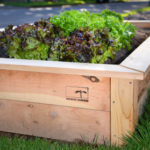 Growing Gardens recently unveiled a DIY planter box made from Juniper, JuniPlanter. In support of the Restoration Juniper Project, they’ve designed a kit that can be built in under an hour by DIY-ers. These boxes are not inexpensive, but they are made to last. The JuniPlanter has more than one model, but as an example, one of the boxes is $450.
Growing Gardens recently unveiled a DIY planter box made from Juniper, JuniPlanter. In support of the Restoration Juniper Project, they’ve designed a kit that can be built in under an hour by DIY-ers. These boxes are not inexpensive, but they are made to last. The JuniPlanter has more than one model, but as an example, one of the boxes is $450.
This is a better investment for a person who knows they are going to be gardening for a long time, rather than someone just starting out.
Build Your Own
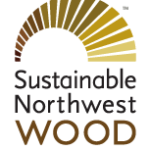 Finding the Juniper wood and building your own would be another option. I talked with Ryan of Sustainable Northwest Wood (SNW) in SE Portland, Oregon. Here are two options Ryan suggested for building an 18″ high 4′ x 8′ raised bed:
Finding the Juniper wood and building your own would be another option. I talked with Ryan of Sustainable Northwest Wood (SNW) in SE Portland, Oregon. Here are two options Ryan suggested for building an 18″ high 4′ x 8′ raised bed:
1. Make your box 18” high using three 2” x 6” (would take 9 boards). Each board at current prices would be $10.00 each so it would cost you $102.75 for the juniper wood for one planter at 4’ wide by 8’ long. They have a corner piece you buy for $12.75 that you can cut to create your corners so you only need one.
2. This option cost more when using 6” x 6” wood. You will need 9 boards at $28.00 each. The cost for one juniper wood planter will be $252. You won’t need a corner piece because the 6 x 6 is strong enough for corners and the whole planter is heftier and better for sitting on.
Ryan’s Construction Tips:
- Pre-drill all holes.
- Use stainless steel lag bolts to use for fasteners.
Designing three Landscape Design in a Days per week, raised planter boxes go in every one of my designs. Everyone wants them! Materials we prefer to use include:
- Corrugated sheet metal with wood supports
- Livestock water troughs
- Stacked rock
- Wood
- Recycled concrete rubble
Schedule your Landscape Design in a Day consultation today with Carol.
Growing Greens Above Ground
I’ve been waiting for years to build my own salad table.
One of the cool things is being able to grow lettuce and other greens without needing to even think about slugs, let alone pick them out of my greens.
It’s also perfect for people with small outdoor living areas, for example I live in a floating home.
Factor in being able to re-purpose my mom’s old metal patio table and the fact that I’m using alot of greens for smoothies makes it just perfect!
If you love the idea of easy access to lettuce and other greens, here’s how to make your own:
Checklist
- Metal patio table with a metal mesh top
- Aluminum roll flashing
- Squeeze clamps
- Tin snips
- Filter fabric
- Caulk
- Pop rivets and a pop rivet tool or a drill, screws and nuts or bolts. Note: This requires more physical strength than I have!
- Potting soil and plants or seeds
Construction Notes
First, cut the fabric to fit the shape of the round patio table. Measure the circumference of the table and then cut the flashing to the correct length so the ends overlap by about an inch.
Pre-cut the flashing with tin snips. For my table this was a 5’ length of 7” aluminum roll flashing.
Next we clamped on the flashing to the table edge. We used pop rivets to attach the flashing to the table. Caulk around the inside edge of the flashing where it meets the table. Set the fabric onto the table and into the edge of sticky caulk.
Let it dry and then add your soil mix and plant your plants.
Credit goes to George Schenk, NW gardener and author of Gardening on Pavement, Table and Hard Surfaces. I love this book!
Boost your nutrition with these exciting small fruit trees
I recently attended a lecture by Jim Gilbert, owner and plant designer of One Green World. They grow and sell edibles tested for NW gardens. My favorite fruit out of the entire lecture was the Pawpaw tree, Asimina Triloba.
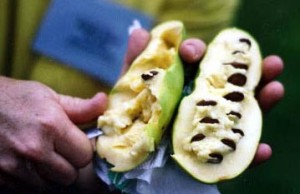
Pawpaw (Asimina Triloba) Think of an avocado that tastes like banana, is high in protein (great for vegetarians) and is easy to grow.
This is a yummy fruit with high proteins and nutrients that tastes like sweet banana, but is low sugar. Since I can’t eat sugar having it taste so good was very exciting to me! Plus, you can’t buy these in a store. Pawpaws can’t be shipped since they bruise easily. “It’s not like an apple that you can just dump out into a bin” according to Jim Gilbert. The most important advise I can give to clients is to select the best tasting and easiest to grow fruit trees. Don’t waste the time it takes to grow a plant to a mature fruit bearing size, when you can buy that same fruit at the supermarket.
The Pawpaw is a small tree native to undergrowth forests in Appalachia. Native Americans introduced Lewis and Clark to the Pawpaw. It’s easy to grow because this naturally dense compact globe shaped tree needs little pruning. It needs afternoon shade so you can plant it near or under an existing tree. This means there is room for this tree even if you have a small yard.
It was fun to hear Jim Gilbert brag about the heavy crop of Golden Sentinel apples from his columnar patio tree. This tree stands out for it’s compact size, disease resistance and it’s flavor which is like an improved Golden Delicious. It’s versatile too, eat them fresh, use them for baking or cider. There are many apple trees that would pollinate a Golden Sentinel, but my favorite is a Callaway Crabapple. I selected this tree because it matures at 6 feet tall so should fit into even a small landscape, and flower and fruit are quite beautiful. Plus it is still disease resistant and great for fresh eating and jelly. If your space is very limited use another columnar variety.
Check out this article Exotic Edibles to read more about some of the new super foods that you can grow to increase your nutrition and good health.
Big news for One Green World! Their farm outlet store is now located at 6469 SE 134th Avenue just off of Foster Road opens January 21st, 2014.
Categories
- Accessory Dwelling Unit ADU
- Before and Afters
- Customer Testimonials
- Deck Design
- Design Basics
- Designers Journal
- Dog and Cat Friendly Gardens
- Dramatic Flowers
- Dramatic Flowers
- Drought Tolerant Garden
- Easy Edibles
- Fall Gardening
- garage design
- Garden Pests
- Garden Tips
- Gardening Green
- Landscape Styles
- Low Maintenance Landscape Examples
- New Improved Plants
- No lawn back yard
- No Lawn Front Yards
- outdoor living
- Parking Strips
- Plants I Recommend
- Privacy
- Rain Garden
- Seasonal Event
- Shade Garden Tips
- Shade Plants
- Spring Gardening
- Summer Garden Tips
- Synthetic Lawn and Dogs
- Tree Selection
- Water features
- Winter Gardening
Let’s make your landscape beautiful.
Get these easy and simple tips on how to keep your garden, patio, or other outdoor entertaining places beautiful. You’ll also receive my monthly newsletter and stay up to date on: design ideas, dog friendly designs, native plants, nurseries we love, upcoming garden events and tours.
What we offer
How to contact us
- 503-223-2426
- Email us on our contact page
- Landscape Design In A Day
- 1511 SW Park Ave #710
- Portland, OR 97201
Recent blog posts
- Designing a Charming Outdoor Living Space in Overlook Neighborhood for 20 Guests: Part Two
- Designing a Charming Outdoor Living Space in Overlook Neighborhood for 20 Guests: Part One
- Custom Irvington Neighborhood Landscape Sees New Life With New Owners
- Update on Back Yard Design for Irvington Neighborhood Baby Boomers – Part 2


